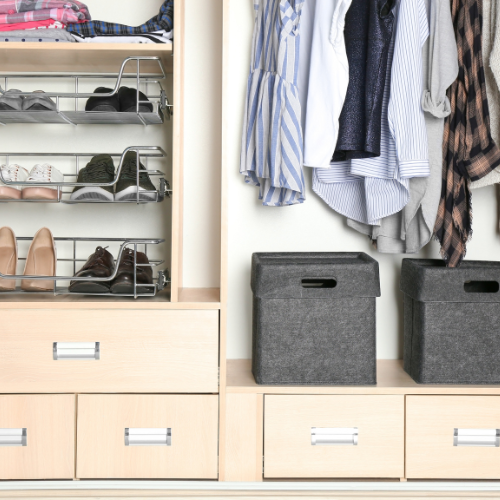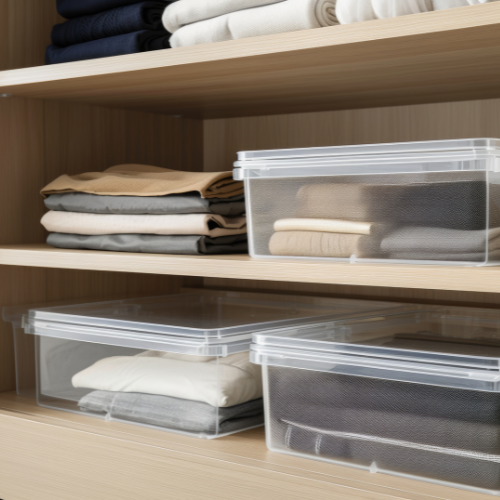As the seasons change, so do our clothing needs. From cozy sweaters in winter to lightweight summer dresses, having a seasonal closet swap system can make transitioning your wardrobe seamless and stress-free. Here’s how to do it efficiently and effectively.
Key Takeaways
- Declutter First: Use seasonal transitions as an opportunity to evaluate your wardrobe and donate or discard items you no longer need.
- Organize by Season: Create dedicated storage for off-season clothing to free up space.
- Use Smart Storage Solutions: Invest in bins, vacuum-sealed bags, and clear containers to protect your clothes and keep them visible.
1. Start with a Clean Slate
Begin by emptying your closet completely. This step allows you to take stock of your current wardrobe and identify items that no longer fit, are damaged, or haven’t been worn in years. Donate gently used items to charity or sell them online to give them a second life.
Pro Tip: Create three piles: keep, donate, and store. This will streamline the sorting process.
2. Sort by Season
Group your clothing into seasonal categories: winter, spring, summer, and fall. This makes it easy to identify what should stay in your closet and what needs to be stored.
Pro Tip: Use color-coded labels or tags to identify which season each storage bin or bag belongs to.
3. Invest in Quality Storage Solutions
Protect your off-season clothing by storing them properly. Invest in durable, airtight containers to prevent dust, moisture, and pests from damaging your items.
Storage Options to Consider:
- Vacuum-Sealed Bags: Great for bulky items like coats and sweaters.
- Clear Bins: Perfect for keeping clothes visible and accessible.
- Fabric Storage Bags: Ideal for delicate items that need breathability.
Pro Tip: Add cedar blocks or lavender sachets to storage bins to keep clothes fresh and deter moths.
4. Create a Capsule Wardrobe for the Current Season
Simplify your daily routine by curating a capsule wardrobe for the current season. Choose versatile pieces that can be mixed and matched easily.
How to Build a Capsule Wardrobe:
- Select 20-30 core items, including tops, bottoms, outerwear, and shoes.
- Prioritize neutral colors and classic styles that work for various occasions.
- Add a few statement pieces for variety.
Pro Tip: Rotate accessories like scarves, hats, and jewelry to refresh your look without overcrowding your closet.
5. Maximize Closet Space with Smart Organizers
Use closet organizers to make the most of your space. Adjustable shelves, hanging rods, and drawer dividers can help keep everything neat and accessible.
Ideas for Closet Organization:
- Hanging Storage: Use hanging shelves for shoes or folded items.
- Over-the-Door Racks: Perfect for accessories or seasonal items like hats and gloves.
- Shelf Dividers: Keep stacks of sweaters or jeans from toppling over.
Pro Tip: Store heavier items like boots on lower shelves and lighter items like scarves on higher ones.

6. Label and Inventory Your Storage
Keeping track of your stored items will save you time and frustration when the next season arrives. Label bins or bags clearly, and consider creating an inventory list.
How to Inventory Your Storage:
- Write down the contents of each bin or bag.
- Attach the list to the outside of the container.
- Keep a digital copy for easy reference.
Pro Tip: Take photos of stored items to create a visual inventory on your phone.
7. Schedule Seasonal Swaps in Advance
Set reminders to transition your wardrobe a few weeks before the weather changes. This ensures you’ll have everything you need when the new season arrives.
Pro Tip: Align your swap with a deep cleaning session for your closet to keep it fresh and organized year-round.
8. Store Special Occasion Items Separately
Formalwear, costumes, and other rarely worn items should have their own dedicated storage space. This keeps them protected and prevents them from taking up valuable real estate in your closet.
Pro Tip: Use garment bags for formal dresses and suits to keep them dust-free and wrinkle-free.
9. Maintain Your Closet Year-Round
Regular maintenance ensures your closet stays organized and clutter-free. Take a few minutes each week to tidy up and return items to their designated places.
Pro Tip: Adopt the one-in, one-out rule: for every new item you bring in, remove an old one.
Final Thoughts
A seasonal closet swap doesn’t have to be overwhelming. With the right system and tools, transitioning your wardrobe can be a simple and satisfying task. By decluttering, organizing, and investing in quality storage solutions, you’ll enjoy a closet that works for you all year long.
Frequently Asked Questions
Q: How often should I do a closet swap?
A: Ideally, you should swap your wardrobe at the start of each new season or whenever the weather shifts significantly.
Q: How do I store delicate items like silk or cashmere?
A: Use breathable fabric storage bags and avoid hanging items that could stretch or lose shape. Add cedar blocks or lavender sachets for extra protection.
Q: What should I do with clothes I’m unsure about keeping?
A: Store them in a separate “maybe” bin. If you don’t reach for them within a season, it’s time to donate or sell them.
Q: Can I use these tips for small closets?
A: Absolutely! Focus on multi-functional storage solutions, like over-the-door organizers and vacuum-sealed bags, to maximize your space.
Q: How do I keep my stored clothes fresh?
A: Ensure items are clean and dry before storing them. Use scented sachets or dryer sheets in storage bins to maintain a fresh scent.

